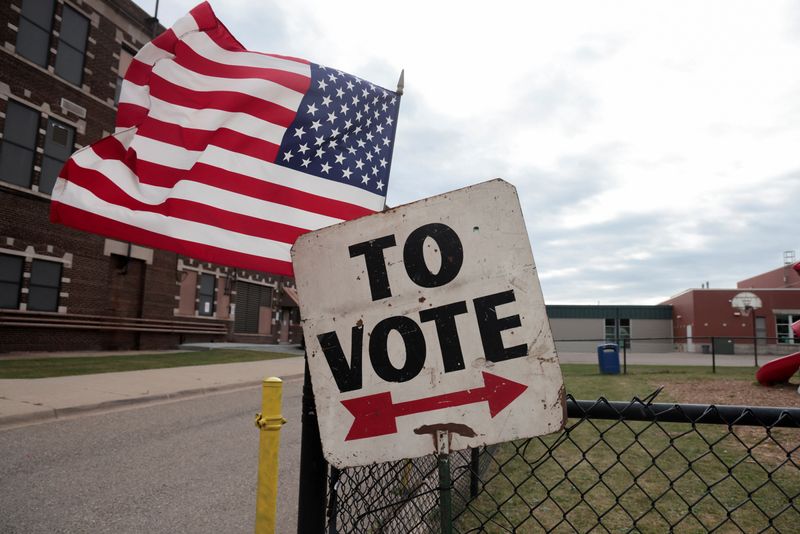From Taiwan to trade, China braces for more rivalry as close US presidential race ends
2024.11.05 12:53
By Antoni Slodkowski, Liz Lee and Larissa Liao
BEIJING (Reuters) – As Americans voted in one of the tightest presidential elections in decades, China braced for an outcome that – regardless of who wins – would spell four more years of bitter superpower rivalry over trade, technology and security issues.
Strategists in Beijing said that while they expected more fiery rhetoric and potentially crippling tariffs from Republican candidate Donald Trump, some said he could be driven by pragmatism and willingness to strike deals on trade and Taiwan.
From Democratic candidate Kamala Harris, Beijing expected predictability and a continuation of U.S. President Joe Biden’s approach centred on working with allies on China-related issues such as tech curbs, Taiwan, and conflicts in Ukraine and the Middle East.
Either outcome was unlikely to cause a shift, said analysts, given how wide-ranging the geopolitical rivalry with Beijing has become, and how politically lethal even a perception of reaching out to China is on both sides of the aisle in Washington.
“Regardless who is elected, the structural tensions are an undeniable reality and have become a widely accepted bipartisan consensus within the U.S.,” said Henry Huiyao Wang of the Beijing-based Center for China and Globalization think tank.
China policies of either Trump or Harris administrations “will likely be strategically consistent,” said experts from Peking University, Wang Jisi, Hu Ran, and Zhao Jianwei in their article in Foreign Affairs.
“As presidents, both candidates would present challenges and disadvantages for China, and neither seems likely to want a major military conflict or to cut off all economic and societal contacts,” they said, adding that because of that, “Beijing is unlikely to have a clear preference.”
Opinion polls show Trump, 78, and Harris, 60, virtually even. The winner may not be known for days after the vote, though Trump has already signalled that he will attempt to fight any defeat, as he did in 2020.
TRUMP TARIFF THREAT
The biggest difference with respect to China policy is on trade, where Trump has proposed tariffs on Chinese imports in excess of 60% and ending China’s most-favoured-nation trading status.
That threat alone has unnerved China’s industrial complex, which sells goods worth more than $400 billion annually to the U.S. and hundreds of billions more in components for products Americans buy from elsewhere.
Producers interviewed by Reuters expected the tariffs to disrupt supply chains and further shrink Chinese profits, hurting jobs, investment and already sagging growth. A trade war would raise production costs and U.S. consumer prices even if factories relocated, they said.
New tariffs could be “very challenging for Beijing given the economic difficulties in China,” said Zhao Minghao, professor at the Shanghai-based Fudan University.
He added that Beijing also had “deeper concerns over the future of the international economic and trade system,” because of Trump’s proposal for a 10% tariff on all goods from other countries.
Robert Lighthizer, Trump’s trade adviser, has vowed to take a strategic decoupling approach in dealing with the U.S.-China economic relations, Zhao noted, “that means significantly decreasing U.S. dependence, U.S. economic ties with China, compared to the derisking approach emphasised by the Biden administration.”
Harris is expected to keep tariffs on hundreds of billions of dollars worth of Chinese imports in place after a Biden administration review of those duties, which were first imposed by Trump.
Democrats have expanded tariffs in areas that they say were of strategic importance to Washington or, they say, threatened by Chinese overproduction, including electric vehicles.
EAST ASIA ALLIANCES
Chinese analysts say that despite Trump’s distrust of NATO and reluctance to work with Western allies, the network of alliances built up in East Asia over the last decade is likely to endure in case of his victory.
They refer to the QUAD alliance of India, Japan, Australia and the U.S., the AUKUS defence technology partnership between Australia, Britain and the U.S., and the trilateral networks between the U.S., its staunch ally Japan, and both South Korea and the Philippines, respectively.
“Even if Trump is unwilling to cooperate with allies, the multiple ‘mini-multilateral’ frameworks built in the Asia-Pacific region during the Biden administration are more likely to be continued,” said Diao Daming, professor at Beijing’s Renmin University.
As vice president, Harris has cultivated relationships in Asia with leaders who are wary of China’s rise, from Japan to the Philippines and Vietnam, aiming for alliances to deter Chinese assertive posture in the region.
For his part, Trump has unnerved democratically governed Taiwan by saying it should pay Washington for its defence and that it had taken U.S. semiconductor business.
Asked in an interview with the Wall Street Journal if he would use military force against a blockade on Taiwan by China, Trump said it would not come to that because Xi respected him, instead vowing to impose additional tariffs on Beijing.
“Given Trump’s predilection for dealmaking, he might decide to pursue bilateral agreements with Beijing on consumer goods, energy, and technology,” said Wang, Hu, and Zhao of Peking University in Foreign Affairs.

“He might also try to use the Taiwan issue as a bargaining chip to gain leverage in other areas, such as offering to restrain Taiwan’s provocative actions in exchange for Beijing’s compromise on trade,” they said.
Still, they said China was “highly unlikely” to “agree to such a deal, and Trump’s foreign policy advisers might also oppose it.”







